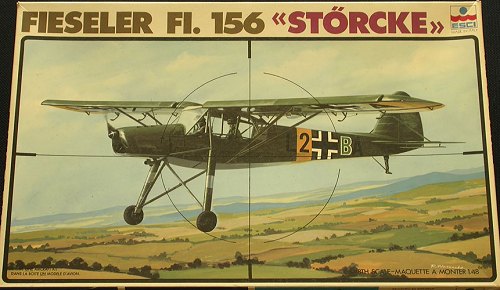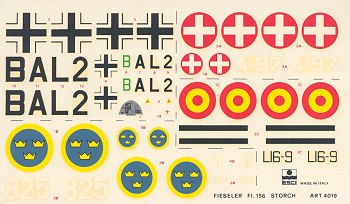
|
KIT: |
ESCI 1/48 Fi-156 “Störcke” |
|
KIT # |
4019 |
|
PRICE: |
$Long OOP |
|
DECALS: |
Four options |
|
REVIEWER: |
Carlos Quiroz |
|
NOTES: |

|
HISTORY |
The Fi-156, or Storch as is also known, was a widely used German aircraft during the World War II. The plane was designed to function as a STOL (short take-off and landing) aircraft and able to fly very slowly, as slow as 51 km/h without stalling thus making it an excellent reconnaissance plane. The plane was able to take off in just 45 m fully loaded and thanks to specially designed legs it could use almost any surface as runway. So much lift generated the airframe that when the wind was too strong, the flaps had to be dismounted to keep the plane in the ground.
Its main use was as reconnaissance platform in all fronts of the war from North Africa to Finland being able to fly slowly making it a difficult target for enemy fighters. Another important role was for liaison duties, in particular Rommel, as most generals, had one for his personal use and both Mussolini and Stalin got them as present before the war. It was also used in Mussolini’s rescue being able to land in a tiny terrace on the back of the hotel he was being held.
After the war the plane production continued for military and civil uses mainly in France. Since the original Argus engine was not longer available, new configurations were designed with other motors but the basic abilities remained. Many of them still fly today.
|
THE KIT |
 As far as I know this is the only model of this aircraft in 1/48 though
several exist in 1/72 and 1/32. Though the box only says it is a Fi-156
the particular variant should be the C-3 version due to the inclusion of
an MG 15 machine gun in the observer location.
As far as I know this is the only model of this aircraft in 1/48 though
several exist in 1/72 and 1/32. Though the box only says it is a Fi-156
the particular variant should be the C-3 version due to the inclusion of
an MG 15 machine gun in the observer location.
The model is composed of 2 tan sprues plus the clear one. The parts look very well molded and without ejections pins or flash in sight. Detail is very crisp, and the bits for the undercarriage and struts are very fine. The cockpit sidewalls are well detailed though the floor and seats could benefit of more detail, for instance adding seatbelts and rudder pedals. The wings are presented in two halves each and have a nice representation of the fabric cover. Flaps and slats are separated and their installation may cause some problems. The clear sprue is quite big due to the nature of the aircraft and it allows you to make one side of the canopy with the door open.
The instruction sheet includes a detailed history
of the plane but the rest of the instructions are quite minimal so a lot
of guesswork will be involved. An annoying detail is that colors are
indicated by name without any pointers to paint manufacturers numbers or
other official numbers. 
The provided model has decals for 4 aircraft including overall black green Luftwaffe and Swedish airplanes also in overall black green. The two other are light gray Swiss and Spanish machines. The decals in my model don’t look very nice and there are signs of yellowing. I’ll probably replace them especially since I’d like to make an airplane with Afrika Korps markings
As for aftermarket Black Magic produces masking templates for the canopy and I for one intend to use them due to the size of the canopy. Cutting Edge has also a detail set that replaces the engine and engine cover. The set can also be used to convert the ESCI Criquet model to Fi-156
|
CONCLUSIONS |
If you want a 1/48 Fi-156 this is your choice. Overall it looks very nice and it doesn’t seem to pose any big problems for constructions. I just wish it would be easier to find alternative markings for this particular model.
|
REFERENCES |
References: Warplanes of the Luftwaffe, edited by David Donald
If you would like your product reviewed fairly and quickly by a site that has over 250,000 visitors a month, please contact me or see other details in the Note to Contributors.